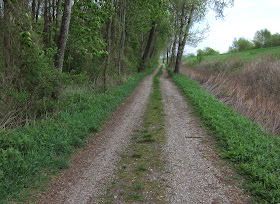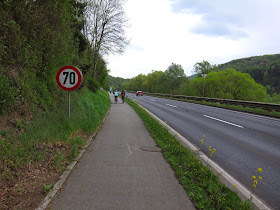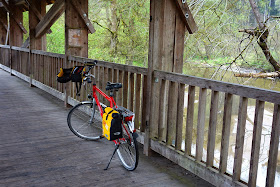Linz to Grein via Mauthausen
I might have found the perfect way to travel. It's relatively guilt free and it's good exercise.
The regime: bicycling between high end hotels where the staff falls all over themselves taking care of you, eating great food in those same hotels in the mornings and evenings and, last but not least, traveling light because a touring company moves your baggage for you while you're pedaling. This makes for a nice vacation, especially if you choose the right trip and the right outfitter. The one I picked is Eurobike's Category A option — which means I stay in 4-star or better hotels and get breakfast. Throw in the bike rental, an extra night in Passau, etc., and it came out to about $1,000. Early April is officially the off season and prices are slightly higher later on.
Anyway, the Arcotel-Linz hotel is definitely a 4-star hotel and the breakfast they put out was an amazing affair. They had everything you could ever want in a breakfast; lox and cheeses, all kinds of pastries including the famous Linzertorte, strange and exotic tepenades and salads, a zillion kinds of breads, rolls and jams to anoint them with, the
de rigueur coldcut platters, fresh fruit and yogurt, even a roast of beef! The tables were laid with fine linen and each had a stainless thermos of coffee waiting.
I left the hotel at about 8:30 in bright sun and I was looking forward to a pleasant day at last. Alas, it was not to be. The weather turned ugly almost immediately. Dark clouds scudded across the sky and when I reached the open river bank, the wind, luckily a tailwind, kicked up. I hurried along because I wanted to visit the Mauthausen Concentration Camp, one the most infamous of the Nazi death camps built during World War II and in which thousands perished under the most horrendous conditions imaginable.
 |
| Leaving Linz |
I arrived in the pretty little town of Mauthausen at about 10 o'clock and was immediately struck by the fact that many of these same homes were here in 1938 when the camp was being built and afterward when it was the scene of the most barbaric cruelty in modern times. The Wikipedia article estimates that between 120-320 thousand people died there. What were these people thinking when they performed services for the SS troops who garrisoned the prison? When they celebrated Christmas with their families?
I have to wonder how these ordinary people could come to accept what was happening up on the hill above town. It must have happened gradually, this acceptance, this feeling that what was happening was deserved by the victims. Most of the people who died there were Jews who were historically reviled in much of Europe and even in the United States in the early 20th century. Adolph Hitler, a charismatic and deeply sociopathic leader, came to power and put forth a theory that these people were the cause of Germany's problems after WWI and in that process intentionally dehumanized them, making them seem to be animals, "the other". The Nazis weren't the first political group to operate this way; Europeans did it with native Americans, the American leadership did it with Vietnamese and Iraqis, but they were more determined and far more thorough than any regime before them.
 |
| Entrance to Mauthausen |
As I entered the camp, the wind picked up and a cold rain began to fall. Here are a few photos of the entrance area, where new arrivals were brutalized, beaten or even killed instantly for the merest offenses. We will never know how many people died in this spot but it is surely a very large number.
.jpg) |
| The prison kommandant stood in this pulpit |
 |
| Prisoners in Mauthausen |
.jpg) |
| Entrance area — pulpit at left center |
.jpg) |
| "Stairs of Death" |
Prisoners were made to carry huge blocks of granite from Mauthausen's quarry up these stairs. If a person couldn't do it or faltered he was severely beaten and often killed in his tracks.
 |
| Stairs of Death |
If the work and inhuman living conditions didn't kill them, there were the gas chamber and ovens waiting.
 |
| Stone tablet in the Room of Names |
.jpg) |
| Book of Names |
Mauthausen was only one of hundreds of such camps that were build during World War II. Many of the towns I visited in my travels had camps either in them or nearby: Passau, Linz, Amstettin, Gusen, Melk, and Vienna. A huge and efficient infrastructure was required to kill 6,000,000 people and these camps were a part of that. After seeing some of the heart rending exhibits and gruesome photos in the museum days later I find myself waking up at night thinking about the camp, wondering how it would be to spend a winter there, naked, starving, beaten, weak, alone, and only sure of one thing; that you would never leave Mauthausen alive. It gives me the shakes.
There are many other photographs in the links at the end of this post. I took in as much of the museum as I could endure but after seeing the Room of Names I was finished. I rode quickly down the steep hill I had walked the bike up two hours earlier and through Mauthausen, this time without without stopping. I reached Grein 3 hours later.
 |
| Entering Grein in light rain |
I had to wait a couple of hours in Grein for a shuttle to take us up the 5 km long climb to the Hotel Aumühle, the only hotel in my tour that was not close to the
Donauradweg. I walked around the pretty little town taking photos in the occasional sunshine.
 |
| I was ready to move right in to this little cottage |
By the time I got to the hotel and unpacked rain had started falling steadily. I was happy to stay inside. I had stopped at a Hofer supermarket where I bought some nice takeaway food; herring in sour cream, cheese stuffed chili peppers, yogurt and sparkling water. I had biked 70 km (43 miles) in 5 hours and 15 minutes.
That night whenever I woke up, images of Mauthausen and what happened there 70 years ago flooded my mind.
Links:
Wikipedia:
Mauthausen Concentration Camp
United States Holocaust Memorial Museum
Reading: Wild, from lost to found on the Pacific Crest Trail, Cheryl Strayed (Kindle ed.)
<< Danube Bike Trip (previous)














.jpg)
.jpg)






.jpg)

.jpg)
.jpg)

.jpg)
.jpg)

.jpg)

.jpg)
.jpg)
.jpg)

.jpg)



















